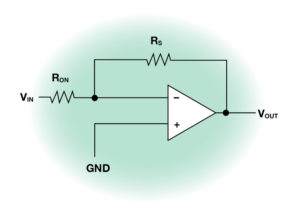Feedback is a term that describes comparing the actual output of a system to the desired output and adjusting the actual output to produce the desired end result. For example, the human nervous system provides constant feedback to the brain, especially when pain is felt for avoiding further bodily harm.
In electronics, feedback is defined as the process of returning part of the signal output from a circuit or device back to the input of that circuit or device.
Feedback systems are widely used in amplifier circuits, oscillators, process control systems, and in many other areas. Benefits of a feedback system include the ability to precisely control gain (e.g., amplification of a signal in an op amp), improve linear response, reduce signal distortion, and to control signal fluctuations. Feedback is sometimes referred to as a “closed loop” system. This means that an output signal is attached to the input of a device or system, forming a “loop.” The opposite of a closed loop or feedback loop is an “open loop” system where there is no feedback, and thus no corrective action based upon the output signal or what’s currently happening.
In control systems, the desired result is either to increase the input (positive or regenerative feedback) or to decrease the input (negative or degenerative feedback). In positive feedback control systems, the positive feedback is in phase with the input, which makes the output larger, i.e., results in system gain. An early use of positive feedback was regenerative circuits invented in 1914 for the amplification and reception of very weak radio signals. These circuits allowed radio signals to be amplified up to 100,000 times in one stage, although early circuits tended to be unstable and oscillated. Today, positive feedback is primarily used in electronic oscillators to increase gain and narrow bandwidth. Positive feedback adds to the signal that needs correction, based on the output. One example is a radiator with a hot water valve and thermostat. If the temperature in a room gets too cold, the valve needs to increase the amount of hot water to the radiator to get the temperature back to a comfortable level. Here, the relationship of the input signal to the output signal (to the valve) is inverse, and so if the valve is naturally closed, or normally closed, increasing the amplitude of the signal to the valve provides more energy to further open the hot water valve and heat the room. The thermostat is the feedback mechanism and the temperature in the room is the feedback. In an open loop system, the valve would be connected to nothing.
In negative feedback systems, the negative feedback is out of phase with the input, which reduces the signal, making the output smaller. If we apply the hot water radiator example here, and this time the valve is normally open in its de-energized state, then less voltage applied to the valve would cause the valve to open more. As an aside to control theory, a normally open hot water valve would mean that when the temperature is satisfied, the valve would have maximum voltage applied so that the radiator would no longer heat the room.
Negative feedback is the most common form of feedback control used in all manner of systems. Electronic devices are inherently non-linear but can be made more linear with the use of negative feedback. The negative feedback amplifier was invented in 1927 by Harold Black while working at Bell Labs. Bell used his invention to reduce the overcrowding of phone lines and to extend its long-distance network. Negative feedback was later used by the military to design accurate fire-control systems in World War II. Later uses included operational amplifiers (op amps) and precise variable-frequency audio oscillators.
Op amps may or may not include an external feedback loop, depending on what function it’s configured to do, but if external feedback is not available it is likely configured at a set value in the integrated chip. External feedback allows the designer to adjust i
